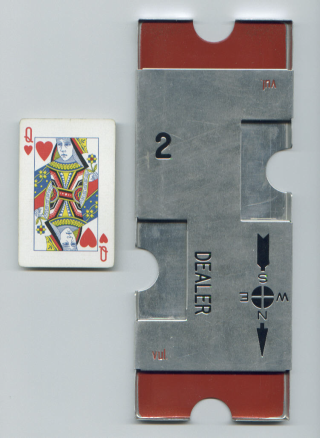Bridge Game
Board
|
Bridge the most popular card game in the worlda
|
Home | Up | Next |
Board

In
duplicate bridge, a board is a device used to pass a pre-dealt
bridge hand from table to table, keeping the cards belonging to each of the
four players separate. More generally, the term board refers to one
"deal" or "hand" of play. In online bridge, there are no physical boards, of
course, but the software emulates all the features.
Markings
Each board contains distinctive markings:
- Board number - Used to ensure the correct board is played at the correct
time.
- Compass - Used to orient the board properly with respect to the four
players at a table.
- Dealer - Designates which player is the "dealer"; in duplicate bridge,
this is used only to designate the player whose turn it is to make the first
call of the auction.
- Vulnerable (red lettering plus red pocket inserts) - Shows which of the
partnerships (if any) are vulnerable. (See
main article for how vulnerability affects scoring.)
Set
A set of boards for duplicate bridge normally contains 36 boards. (The actual
number of boards used in a particular session will vary depending on the number
of players and other factors.) The dealer and vulnerability markings are
standardized for each board number, utilizing all the
permutations.
Pockets
A board contains four pockets, each designed to hold thirteen
playing
cards. At the beginning of a session, the cards are distributed to the
pockets in one of several ways:
- Shuffle and play - a player at the first table to receive the board
removes the cards from all four pockets, shuffles, cuts, deals them into
four piles, and puts one pile into each pocket. It does not matter which
player prepares which board. Usually, each table receives a number of boards
and the players will prepare the different boards simultaneously.
- Predealt - the sponsoring agency has prearranged the cards in the
boards, and the boards are given to the players "ready to play".
- Computer dealt - a number of boards are delivered to each table with the
instruction to "sort into suits". A player takes each board and sorts the
cards into suits and (usually) by rank, and places one suit face up in each
pocket. Hand records are distributed to each table showing which
cards are to be dealt to each hand. (Such hand records are usually prepared
in advance by a
computer program using a pseudorandom number generator.) The players cooperate in dealing the
cards according to the hand record and placing the correct cards in each
pocket. Of course, these boards will be passed to another table and never be
played by the players preparing them.
No matter how the boards are prepared, they are not shuffled again during the
session, and the cards in all pockets are kept face-down. Sometimes, at the end
of a session or the beginning of a new session, a card or cards will be placed
in the board face-up. This indicates that the board has not yet been prepared
for the new session.
Apart from the cards, on pairs tournaments the board also carries a
traveling sheet ? a paper form where competitors at each table enter their
scores. The board may contain a dedicated pocket for the traveling sheet, or it
can be placed atop of one card pocket (usually, North's, since North-South pairs
are responsible for filling it in).
Play
Play of each board proceeds as follows:
- The north player positions the board in the center of the table (perhaps
at the top of a stack of boards).
- Each player removes the cards from the pocket in front of her.
- Each player counts her cards before looking at any card face. The
director is summoned if any player does not have exactly thirteen cards.
- The players look at their cards (without showing any card face to any
other player at the table) and optionally arrange them according to personal
preference.
- The player designated as the dealer on the board makes the first call.
- The bidding is completed and play proceeds.
- To play to a trick, each player shows a card face or places a card face
up on the table in front of her. The cards belonging to two different
players are never mixed together like they are in rubber bridge.
- After four cards are played to a trick, each player turns her card face
down and places it in a row in front of her, overlapping left to right. If
her side won the trick, it is placed straight up; otherwise, it is laid
sideways. This is used to determine how many tricks each side has won at any
time.
- After the play, the scoring is agreed, and then each player gathers her
own cards, shuffles them (with themselves only), and replaces them in the
board pocket from which they came. The shuffle ensures that the next player
can make no inference from the ordering of the cards in her pocket.
Home | Up | Board | Traveling sheet
duplicate bridge, board, device, pass,
pre-dealt bridge hand, table to table, separate, deal, hand, play, online
bridge, physical boards, emulates
